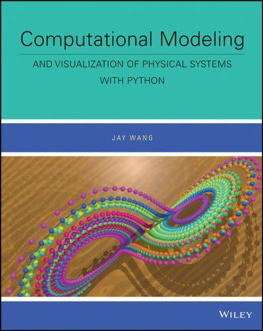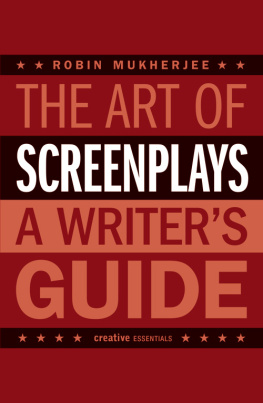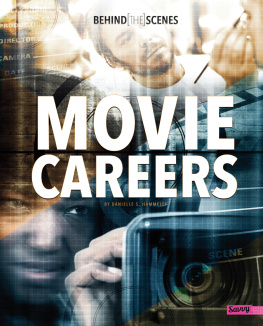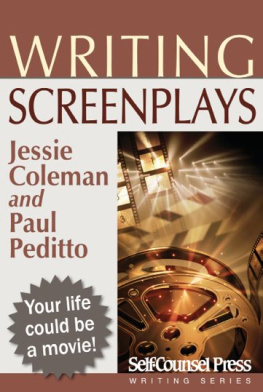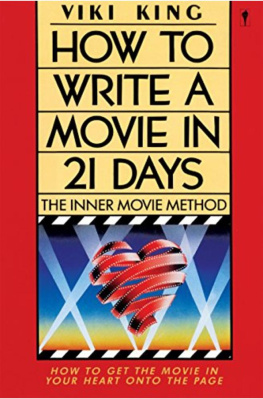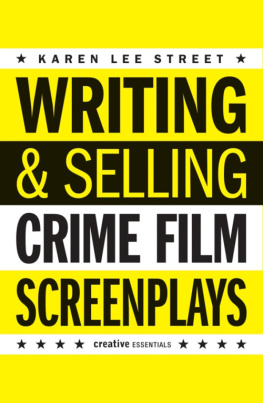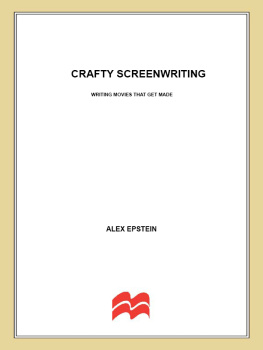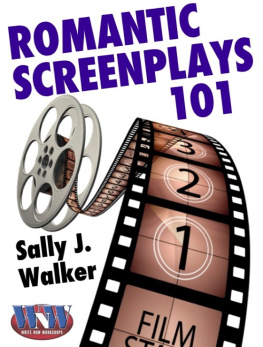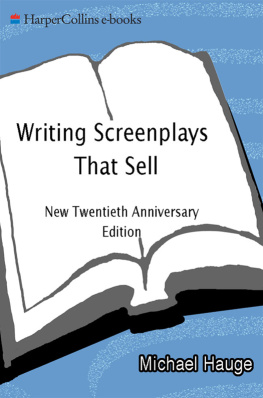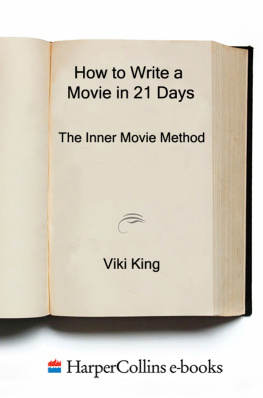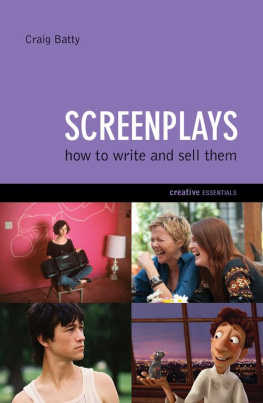Wang - Writing Scenes For Screenplays: (The 15-Minute Movie Method)
Here you can read online Wang - Writing Scenes For Screenplays: (The 15-Minute Movie Method) full text of the book (entire story) in english for free. Download pdf and epub, get meaning, cover and reviews about this ebook. year: 2022, genre: Romance novel. Description of the work, (preface) as well as reviews are available. Best literature library LitArk.com created for fans of good reading and offers a wide selection of genres:
Romance novel
Science fiction
Adventure
Detective
Science
History
Home and family
Prose
Art
Politics
Computer
Non-fiction
Religion
Business
Children
Humor
Choose a favorite category and find really read worthwhile books. Enjoy immersion in the world of imagination, feel the emotions of the characters or learn something new for yourself, make an fascinating discovery.

- Book:Writing Scenes For Screenplays: (The 15-Minute Movie Method)
- Author:
- Genre:
- Year:2022
- Rating:3 / 5
- Favourites:Add to favourites
- Your mark:
- 60
- 1
- 2
- 3
- 4
- 5
Writing Scenes For Screenplays: (The 15-Minute Movie Method): summary, description and annotation
We offer to read an annotation, description, summary or preface (depends on what the author of the book "Writing Scenes For Screenplays: (The 15-Minute Movie Method)" wrote himself). If you haven't found the necessary information about the book — write in the comments, we will try to find it.
Wang: author's other books
Who wrote Writing Scenes For Screenplays: (The 15-Minute Movie Method)? Find out the surname, the name of the author of the book and a list of all author's works by series.
Writing Scenes For Screenplays: (The 15-Minute Movie Method) — read online for free the complete book (whole text) full work
Below is the text of the book, divided by pages. System saving the place of the last page read, allows you to conveniently read the book "Writing Scenes For Screenplays: (The 15-Minute Movie Method)" online for free, without having to search again every time where you left off. Put a bookmark, and you can go to the page where you finished reading at any time.
Font size:
Interval:
Bookmark:
I.
II.
III.
To everyone who yearns to tell a story. You can do it. Your biggest obstacle in your life will always be overcoming your own fears and doubts.
Every story takes a hero on a journey. In the beginning, the hero has a goal. By the end, the hero either gets that goal or fails to get that goal. This is why story endings are fairly predictable. In a mystery, the detective catches the criminal. In a romance, two people finally find true love. In an action thriller, the hero defeats the villain.
What makes every story unique isnt the type of ending, but the details that describe how the hero gets from the beginning to the end. Long stories (novels, stage plays, and screenplays) cant jump from the beginning to the end right away or the story would be over too soon. Instead, all types of long stories must develop step-by-step through building blocks known as scenes.
To tell any type of lengthy story, writers must tell that story through multiple scenes. Just as a chain is only as strong as its weakest link, so any story will only be as strong as its weakest scene.
Imagine someone flipping through a novel, stage play, or screenplay at random. If they dont read something interesting in any random part of the story, theyll likely put the story down and never bother reading the rest of it. That means every scene in a story must be grab a readers attention, hold it, and compel the reader to turn the next page to find out more. When all your individual scenes can do that, youll likely have an equally compelling long story as well.
What you can never do is write a handful of great scenes surrounded by mediocre scenes that simply exist to move the story along. Nobody (except the writer) will ever have the patience to wade through multiple mediocre scenes in hopes of eventually getting to the good scenes.
Every story must consist of nothing but the best possible scenes. This book will help you understand how scenes work, how to structure each scene as a mini-story, and how to link one scene to another so they keep your story moving towards an exciting conclusion.
Scene writing is a crucial part of storytelling. When you can master writing a single scene, youre well on your way to mastering a longer story. If you cant write a single compelling scene, you wont be able to tell an interesting longer story with dozens of separate scenes either.
Although this book focuses solely on screenwriting, the principles remain the same for all types of storytelling. If you want to write a novel, stage play, or screenplay, you must understand how to write a compelling scene that grabs the reader and never lets them go. Writing great scenes is the first step towards writing and telling a great story.
How to Use This Book
Scenes are the building blocks of every story. Yet far too many novices try to write a story without taking time to understand how scenes work, how scenes are structured, and which scenes are crucial to any story.
Trying to write a story without understanding how to write a scene is like trying to build a house without understanding how to nail wood together or why you need to lay a foundation before you try to build a house. Without such crucial knowledge, all the best attempts will likely be far more troublesome and frustrating than they need to be.
The purpose of this book is to help you understand how to write a scene. Once you can write a single scene well, you can write dozens of scenes well. Until you can write one scene well, youll never be able to write any story that can grab someones attention and make them want to give you money.
The first part of this book focuses on helping you understand the crucial scenes in any story. Whether youre writing a comedy, a romance, a mystery, a thriller, or a horror story, all scenes consist of the same foundational scenes. You need a beginning and an end, but you also need to know how the beginning and end work together to tell a unified story. Rather than write a story from start to finish, consider writing scenes out of order.
Once you understand which major scenes every story needs and how these major scenes relate to each other, you can write more cohesive stories. By outlining and writing these major scenes first, you can quickly and easily structure a large part of your entire story. Once you know where your story is going, its much easier to write scenes that support that story.
You can come up with the greatest idea for a story but if you cant tell that story in a compelling way, your great idea might as well be invisible. By understanding how to write compelling scenes that grab and hold attention while telling an intriguing story, you can write scenes that people will want to read.
Just remember that writing is never about following a formula. Instead, use the suggestions in this book as guidelines to help you get unstuck and structure your story. Follow your story, not any arbitrary writing rules.
Write great scenes and you can write great stories. Its really that simple.
The worst way to write a screenplay is to come up with an idea and start writing. This approach inevitably creates a weak story that runs out of ideas within a few pages. Trying to salvage a hasty idea at this point will likely create nothing but a jumbled mess.
A far better idea is to plan your story ahead of time before you start writing, and thats what this book is about. Of course, to plan a story, you need to understand the crucial types of scenes every screenplay needs. Once you know the purpose of different types of scenes and how they work to create a compelling story, then youll be able to plan your own story.
Part I of this book focuses on revealing the crucial types of scenes every story needs regardless of the genre, tone, setting, or characters. Every story is built out of structural scenes and this part of the book will help you identify and understand these types of scenes so you can create them in your own screenplay.
T he purpose of a scene is not to tell a story. When you try to tell a story, youll risk dumping information in the readers lap like a pile of soggy magazines and newspapers. Nobody reads a scene because they want to learn about your story. Everybody reads a scene because they find it interesting. Because a scene is interesting, people will eventually learn about your story.
You cant tell a story until youve grabbed a readers attention. You cant tell a story unless you can hold a readers attention. Therefore the main purpose of every scene is to:
- Grab the readers attention
- Hold the readers attention
Grabbing Attention
If you can't write a scene that grabs and holds attention, nothing else matters. The number one priority must always be grabbing and holding attention. Only then can a scene gives us information about that story. The moment a scene fails to grab and hold attention, the entire story is lost.
To understand how scenes grab attention, study the opening scene of any movie such as the following:
- Star Wars - (Conflict) Battle scene between a large starship chasing after a smaller starship.
- Dont Breathe - (Mystery) A man drags an unconscious woman through the streets of an abandoned neighborhood.
- Rocky - (Conflict) Two boxers fight in a dingy arena.
- Top Gun: Maverick - (Mystery) The hero taps a calendar date with the words Mach 9 written inside one day.
Font size:
Interval:
Bookmark:
Similar books «Writing Scenes For Screenplays: (The 15-Minute Movie Method)»
Look at similar books to Writing Scenes For Screenplays: (The 15-Minute Movie Method). We have selected literature similar in name and meaning in the hope of providing readers with more options to find new, interesting, not yet read works.
Discussion, reviews of the book Writing Scenes For Screenplays: (The 15-Minute Movie Method) and just readers' own opinions. Leave your comments, write what you think about the work, its meaning or the main characters. Specify what exactly you liked and what you didn't like, and why you think so.


